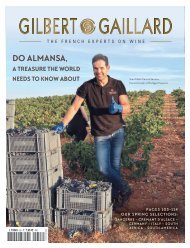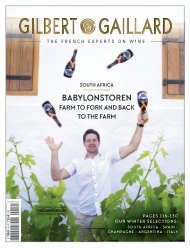You also want an ePaper? Increase the reach of your titles
YUMPU automatically turns print PDFs into web optimized ePapers that Google loves.
GERMANY<br />
CLIMATE<br />
GERMANY’S WINE INDUSTRY<br />
Germany has 13 wine regions, mainly in the south-west of the country, among which<br />
Rheinhessen and the Palatinate have the largest vineyard acreage. With 103,000 ha<br />
under vine, the country ranks 14 th worldwide, but has seen its area increase by 8.4% in<br />
the last 30 years. The most widely grown grape varieties are Riesling (stable acreage),<br />
Pinot Noir (significantly increasing) and Müller-Thurgau (significantly decreasing).<br />
Two thirds of the grape varieties remain white, while the red wine boom of the 2000s<br />
has weakened a little in recent years. The biggest winners over the last two decades<br />
are Pinot Blanc and Pinot Gris, both of which have doubled their area under vine.<br />
What isn‘t yet strongly reflected in the statistics are experiments with ‘southern’ grape<br />
varieties, which are primarily evident among red grapes. Thanks to global warming,<br />
Merlot has now statistically reached 20th position (790 ha country-wide), and Cabernet-Sauvignon<br />
22nd. Steep-slope projects, co-financed by the government, have seen<br />
grape varieties such as Nero d’Avola and Tannat be put into the ground. German<br />
Syrah, too, has entered the winegrowing world with some remarkable examples.<br />
Another trend is that of newly propagated fungus-resistant grape varieties (hybrids)<br />
which are also gaining considerable traction.<br />
EVENING LIGHT ON KIRCHENSTÜCK IN PALATINATE, PROBABLY THE MOST PRESTIGIOUS SITE FOR DRY RIESLING IN ALL OF GERMANY<br />
58 AUTUMN 2022 • GILBERT & GAILLARD - THE FRENCH EXPERTS ON WINE

















